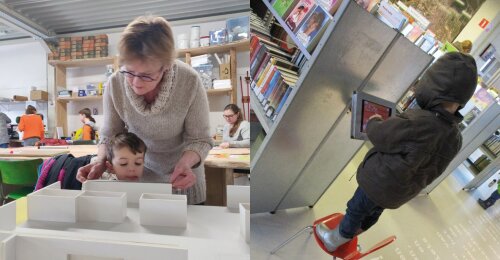Challenging the concept of user-fit design. A path towards developing an integrated knowledge framework and a practical instrument to facilitate user-fit design, focusing on explicitly incorporating chidren’s needs into public library (re)design
Promotors: Nathalie Vallet, Inge Somers
This doctoral research on 'user-fit design' arose both from a personal motivation as a spatial designer and from a specific need identified by several academic and practitioner experts. By combining the three key concepts of 'user', 'fit' and 'design', we aim to highlight the important, but not always obvious connection between a spatial design and its future end-users. Through an exploratory literature review and some exploratory interviews, we encountered three main limitations in already existing, multidisciplinary research. Besides a (i) terminological tsunami (including 'user design', 'people-, human- or user-centred, -oriented or friendly design', 'socially responsive design', 'empathic design' and 'inclusive design') and a (ii) content-specific tsunami of developed knowledge and insights, we also notice a (iii) relatively limited or scarce application within the spatial design disciplines of interior and architecture. Together, these observations determined the further focus of this doctoral research. Using an exploratory, qualitative research methodology, we sought to clarify the exact meaning, causes and (design) implications of the concept of 'user-fit design' in a self-developed integrated knowledge framework, as well as increase its more operational and practical applicability in a self-developed deployable instrument. In line with the requirements of exploratory qualitative research, we combined various research methods, including a multidisciplinary literature review, document analysis, open and semi-structured interviews, focus group discussions, inspiring existing case studies (i.e. reference research) as well as empirically designed or initiated case studies (i.e. workshop research). From an initially generic approach, we further focused this doctoral research on (I) (re)designing public libraries as a specific type of building and (II) (re)designing for/with children as a specific end-user profile. After all, based on the initial information gathered and the ongoing research of my supervisor Nathalie Vallet, achieving user-fit design by spatial designers in both specific situations turns out to be a great(er) challenge. Besides developing an integrated knowledge framework as well as a practical instrument, this doctoral research also made us aware, above all, of the many preconditions, often uncontrollable for the spatial designer, that (help) determine whether or not user-fit design is achieved. For example, a lot of user-fit design strategies are not exclusively linked to the design process steered by the spatial designer, but equally linked to the context-, outcome- and/or role-related features of the wider design project steered by third parties (e.g. clients, intermediate users and financiers). In short, based on the findings in this doctoral research, the realisation of user-fit design is not only the mandate and responsibility of spatial designers, but also of a complex and multifaceted playing field of different stakeholders. Finally, we would like to conclude that in keeping with the tradition of exploratory qualitative research (i.e. long term research), this doctoral research has, above all, developed a reality-based, well-organised, systematic and useful foundation on which to build in the future. It appears the road to user-fit design is not only a broad, crowded one, but also a long one.
